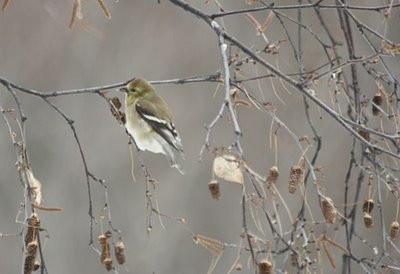
American goldfinches and pine siskins are always working on the seeds of the gray birches we've planted all over the yard. What they knock to the snow, the juncos, tree sparrows and field sparrows clean up.
Sumac rings all our meadows--five species in all. Here, a red-bellied woodpecker works on the fruits.
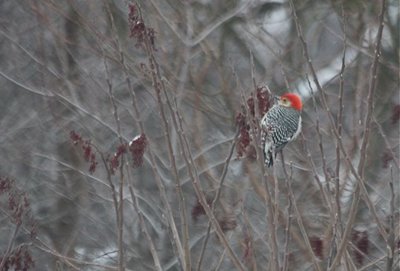
Turning about, he shows the origin of his seeming misnomer. I love this shot.
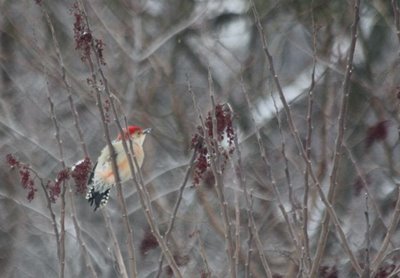
To me, the northern flicker is so impossibly beautiful that I can hardly believe it exists. I love, love, love to paint flickers. There's so much to do! This is a male, with a black moustache mark.
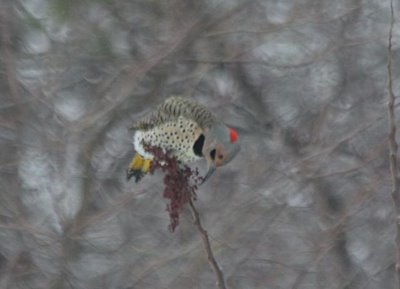 Sumac is a good food for wildlife because there's nothing in it that spoils or ferments, and it stays fresh from when it first ripens in October until at least May. It's always available, kind of the way All-Bran is always around. It may not be your first choice, but it's food.
Sumac is a good food for wildlife because there's nothing in it that spoils or ferments, and it stays fresh from when it first ripens in October until at least May. It's always available, kind of the way All-Bran is always around. It may not be your first choice, but it's food.As I shot the flicker, I was wishing hard that I was closer, that it wasn't so gray out...and yet the images have a simple beauty that I love.
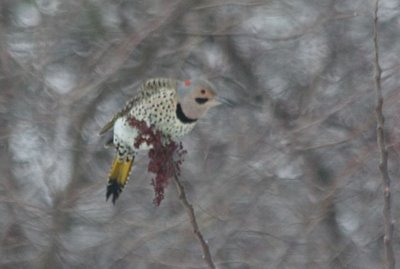 Who thought up all those markings? They are perfect. The bird is cryptic from above, spectacular from below--good for a ground-feeder. Flickers huddle on the ground, digging for ants in the summer, and they're all but invisible to predators with those brown-barred backs.
Who thought up all those markings? They are perfect. The bird is cryptic from above, spectacular from below--good for a ground-feeder. Flickers huddle on the ground, digging for ants in the summer, and they're all but invisible to predators with those brown-barred backs.Yet when they wish to make a splash they've got all the badges and bling they need.
Ahh. That's the one. I must paint it someday.
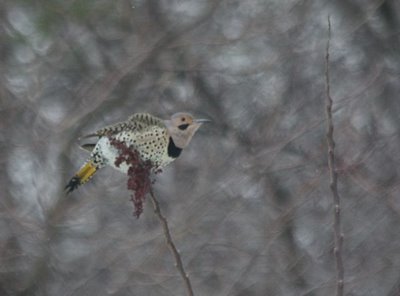






13 comments:
Gorgeous!
Oh, I love northern flickers! When I came upon a group of them nibbling in the grass some distance from me, I took a few photos before stopping--stopping just so I could enjoy the beauty of it all. They're such wonderful sights to behold.
And a suggestion for you, Julie: The XSi (and probably the XTi) supports teleconverters. Depending on the 300mm lens you're using, you might consider buying a 2xTC. It would turn your 300mm lens into a 600mm lens. Sure, there's a wee bit of quality loss, but overall it wouldn't be much--especially compared to the gains you'd make in distance.
I love flickers! They're among the fanciest birds out there, plus I love their ground-feeding habits. When you next paint one, is there any chance manage to add its white rump patch to that bird bling?
(I love that you're managing to feed us an Ohio diet while you're dining in Jipip.)
There should be a you'll between chance and manage in that last message.
I'm now off to write "I must proof before I post" one hundred times.
Hi guys--sitting on a rainy veranda in Honduras. Let's see: altimira oriole, northern jacana, purple gallinule, magnolia warbler, golden-fronted woodpecker, cinnamon hummingbird. And Robert Ridgley (Birds of Panama, Birds of South America) spooking around, helping people with ID questions. And wireless. It isn't too bad.
Jason, I didn't know I could do a doubler on this lens--wow! I need that. Thanks.
ahhhh, flickers I think are one of the most under-appreciated birds, their full beauty not evident until seen up very close (as Roger Tory Peterson saw one in childhood, propelling him on his wonderful career).
And a bird rehabber friend of mine once ended up with a nestfull of baby flickers to raise and release, and they were among the cutest baby birds I've ever witnessed.
You know, those photos DO look painted, sort of. The background reminds me of wrinkled, gray homemade paper.
I want sumac. You said that you have 5 species...are they all native to OH? Do they need dry or wet? Sun or shade? I have it all.
Inquiring minds wanna know!
Julie-
Great environmental portraits!
I don't think that the 300 mm lens that you use would autofocus with a 2x teleconverter. I'm not exactly sure what you guys have, but I don't even think it would autofocus with bill's 300 f 4.0 (at least that's what I think he has from reading your guys blogs!)
Last year I rented a lens which I think you would love- the Canon 400 5.6L. Check out some photos i got with it at:
TA Photos
Tom
Yeah! That's the one! I love Flickers and rarely see them. Whenever I flip through a field guide, there's always a pause and ahhh for a Flicker.
Lovely post, Julie!
Groundfeeder, my aunt Fanny. One of these (Western version) has been on our third floor drilling away. There's a major hole in our house--you could leave your car keys in there. It does look natty drilling, though.
I am with the birds on sumac! Some variety of it is a staple spice in Middle Eastern cooking. Rubbed into a chicken with other spices before roasting or grilling... sprinkled over baba ganouj or hummous ... lots of citrusy goodness.
Nice to think that a Zickeflicker may be in the works one day!
I have always thought that flickers are overloaded with good field marks. Perhaps they could lend some to the needy sparrows and flycatchers.
Argh, your list of birds from Honduras is making me miss Costa Rica... I love jacanas, they have the most amazing feet!
Post a Comment